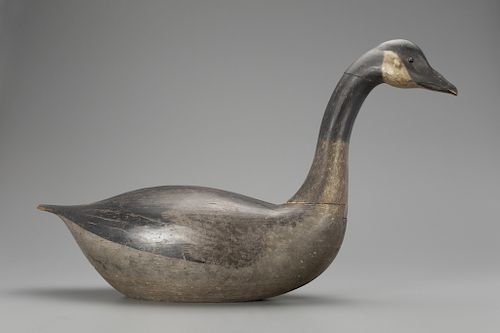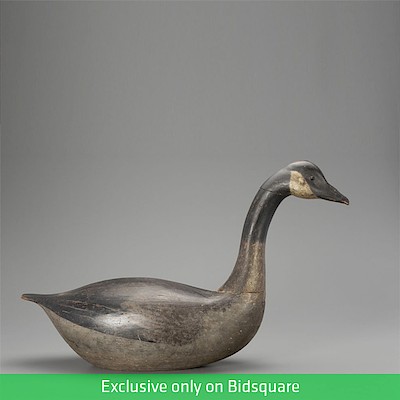Earnest-Gregory Dovetailed Goose
Lot 12
About Seller
Copley Fine Art Auctions
20 Winter Street
Pembroke, MA 02359
United States
Founded in 2005, Copley Fine Art Auctions is a boutique auction house specializing in antique decoys and American, sporting, and wildlife paintings. Over the course of the last two decades, the firm has set auction records for not only individual decoy makers, but also entire carving regions. Copley...Read more
Estimate:
$500,000 - $800,000
Absentee vs Live bid
Two ways to bid:
- Leave a max absentee bid and the platform will bid on your behalf up to your maximum bid during the live auction.
- Bid live during the auction and your bids will be submitted real-time to the auctioneer.
Bid Increments
| Price | Bid Increment |
|---|---|
| $0 | $50 |
| $1,000 | $100 |
| $2,500 | $250 |
| $5,000 | $500 |
| $10,000 | $1,000 |
| $25,000 | $2,500 |
| $50,000 | $5,000 |
About Auction
By Copley Fine Art Auctions
Jul 19, 2018
Set Reminder
2018-07-19 13:00:00
2018-07-19 13:00:00
America/New_York
Bidsquare
Bidsquare : The Sporting Sale 2018, Day 1
https://www.bidsquare.com/auctions/copley/the-sporting-sale-2018-day-1-3286
On July 19, Copley Fine Art Auctions will lead off their annual Sporting Sale with 140 lots from the Donal C. O’Brien, Jr. Collection of Important American Sporting Art and Decoys. On July 20 Copley will present an additional 425 lots of decoys, fish carvings, and sporting art. Copley Fine Art Auctions cinnie@copleyart.com
On July 19, Copley Fine Art Auctions will lead off their annual Sporting Sale with 140 lots from the Donal C. O’Brien, Jr. Collection of Important American Sporting Art and Decoys. On July 20 Copley will present an additional 425 lots of decoys, fish carvings, and sporting art. Copley Fine Art Auctions cinnie@copleyart.com
- Lot Description
Earnest-Gregory Dovetailed Goose
Massachusetts or Pennsylvania, c. 1870
29 1/2 in. long, 17 1/2 in. high
Few, if any, decoys conjure the imagination more than the three elegant Canada goose creations by this unknown maker. They were sourced over sixty years ago, in 1954, by famed collector and author Adele Earnest (1901-1993) in Columbia, Pennsylvania, and she credits these exact birds for inspiring her “subsequent devotion to the decoy as an art."
Upon first impression the decoy's presence is commanding. Quickly, the subtle refinements present themselves and invite the viewer to enjoy its features from tip to tail. The artist’s rendering of the bill perfectly captures the nuances of the species, starting with delicate mandible, nostril, and incised carving at the face connection. The head is carefully sculpted with pronounced cheeks and eye grooves that finish at the back of the crown. The bead-glass eyes are carefully inset in perfect symmetry. The graceful S-shaped neck flares at its dovetailed base, fashioned for easy removal when transporting the the decoy to and from the field. The bottom of the dovetail reveals a two-tone painted “4” that corresponds to a matching number inside the joint within the body. In addition, both head and body sections have a matching incised delta.
The maker’s construction techniques and wood selection were meticulous. The maker retained the strength of his wood through the long neck and forward-reaching head by joining two pieces at a complex lap joint. The decoy, sculpted in a swimming pose, shows intricate detail carving behind the head, and the full body features a subtle chine that runs along the length of the bird’s back. The maker went to great lengths finishing the underside of the thin paddle tail with fastidious gauge carving rarely seen on the underside of any decoy. The bottom of the decoy was then fitted for a cross-shaped inset weight. True to his craft, the maker's diligent work is further revealed in x-rays, most notably in the painstakingly hand-carved hollowing of the body.
Two of the three Earnest dovetailed goose decoys were acquired by iconic folk art collector Stewart E. Gregory (1913–1976) of Wilton, Connecticut. Gregory was the Chairman of the Board of the Wilton Historical Society, in addition to serving as both the vice president and a trustee for the American Folk Art Museum during the 1960s and 70s.
Gregory’s collection contained numerous pieces acquired from early and noted dealers, including Mary Allis (1899-1987) and Adele Earnest. His prominent folk art collection featured works by Ammi Phillips (1788-1865) and Erastus Salisbury Field (1805-1900), in addition to decoys, hooked rugs, weathervanes, and tinware. The American Folk Art Museum exhibited Gregory’s collection in the 1972 exhibition titled “An Eye on America: Folk Art from the Stewart E. Gregory Collection.”
Seven years later, this decoy and its mate were both sold at the Stewart E. Gregory Sale at Sotheby Parke Bernet in 1979. It was at this auction that O’Brien acquired the bird.
According to American Folk Art Museum Director Gerard C. Wertkin, the Gregory Sale “is often considered a watershed in the field because of the widespread public interest that it engendered and the high prices that it realized. Indeed, many of the finest works acquired by Gregory are now in the collections of important American museums.”
The decoy was next displayed publicly at the American Folk Art Museum in the fall of 1981 as part of an exhibit titled "The Art of the American Decoy: Folk Sculpture from the Collection of Mr. and Mrs. Donal C. O’Brien Jr." The exhibition featured seventy-three classic decoys from the couple’s collection.
Specialists in the decoy collecting world have long heralded the Gregory dovetailed birds as the very best the field has to offer. "Antiques and the Arts Weekly" reported that the McCleery sale’s decoy specialists, Frank Schmidt and Gary Guyette, both deemed the Gregory-McCleery goose to be their "favorite" lot in the auction.
O’Brien’s love for these decoys was also widely known. He judged his iconic carving to be not only “the finest bird in his collection,” but also “the best of the two" Gregory geese, due to its highly detailed paint pattern.
Excellent original paint with minor darkening to flaking and chipping at base of head.
Provenance: Adele Earnest, acquired in Columbia, Pennsylvania, 1954 Stewart E. Gregory Collection, acquired from the above Donal C. O'Brien, Jr. Collection, acquired at the Gregory Sale, 1979
Literature: Sotheby Parke Bernet Inc., "Important American Folk Art and Furniture: The Distinguished Collection of the Late Stewart E. Gregory, Wilton, Connecticut," Sale 4209, New York, NY, January 27, 1979, lot 149, exact decoy illustrated.
Loy S. Harrell, Jr., "Decoys: North America’s One Hundred Greatest," Iola, WI, 2000, pp. 176-177, exact decoy illustrated.
Rita Reif, "Carved Birds Captured by a Connoisseur's Eye," The New York Times, January 9, 2000, p. 49, rigmate illustrated.
Adele Earnest, "Folk Art In America," Exton, PA, 1984, p. 125.
Jackson Parker, "O'Brien Classic Decoys on Display," Maine Antiques Digest, November 1981, p. 32-B, exact decoy illustrated.
Adele Earnest, "The Art of the Decoy," New York, NY, 1965, pp. 8-9, rigmate illustrated.
"Decoys and Records: The Dr. James M. McCleery Collection," Antiques and Arts Weekly, February 4, 2000, reprinted in Ronald J. Gard and Robert Shaw, eds., "The McCleery Auction," Dallas, TX, 2001, p. 150.
Laurence Sheehan, "The Sporting Life," New York, NY, 1992, pp. 78, 80, exact decoy illustrated.
Exhibited: New York, New York, “The Art of the American Decoy: Folk Sculpture from the Collection of Mr. and Mrs. Donal C. O’Brien Jr.,” Museum of American Folk Art, September 3–November 8, 1981.Condition report requests can be made via email or by telephone (info@copleyart.com or 617.536.0030). Any condition statement given is a courtesy to customers, Copley will not be held responsible for any errors or omissions. The absence of a condition statement does not imply that the lot is in perfect condition.Condition
- Shipping Info
-
Shipping info
Copley Fine Art Auctions does not handle the shipping of any items. Shipping is the sole responsibility of the buyer. Once your payment has cleared, and we have received your authorized shipping release form items may be released for shipment. Copley Fine Art Auctions, LLC shall have no liability for any loss or damage to such items. Buyers should allow up to four weeks for shipment.PLEASE BE AWARE THAT INTERNET BIDDERS MAY NOT PICK UP THEIR ITEMS AT THE SALE SITE. ITEMS CAN BE PICKED UP BY APPOINTMENT OR SHIPPED STARTING FIVE DAYS AFTER THE CONCLUSION OF THE SALE
-
- Buyer's Premium



 EUR
EUR CAD
CAD AUD
AUD GBP
GBP MXN
MXN HKD
HKD CNY
CNY MYR
MYR SEK
SEK SGD
SGD CHF
CHF THB
THB























